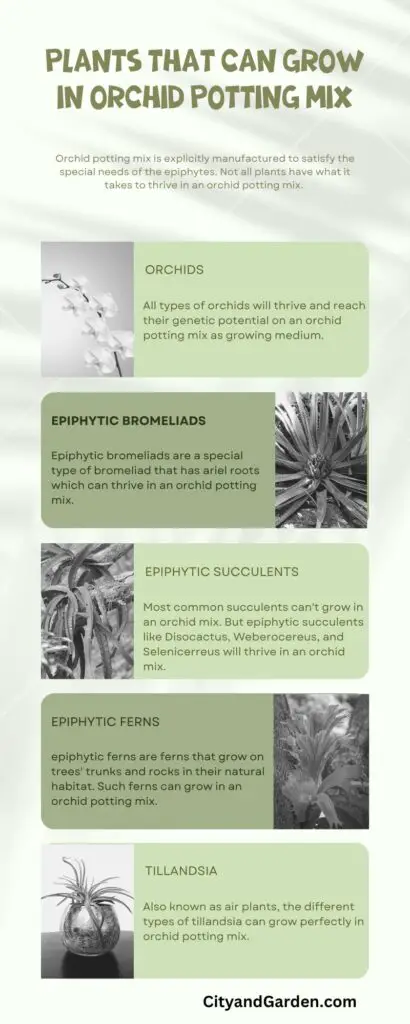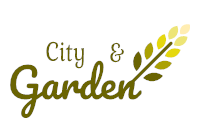Trying new experiments is a wonderful thing. Most probably you have an extra orchid mix. And you wondering whether you can use that orchid potting mix for your other plants.
Since I am someone who loves to find new ways of doing things. I will not betray my values and tell you to not explore it yourself.
But in this article, we gonna review the orchid potting mix properties. And how these properties will affect your other plant’s growth while giving you the list of plants that for sure can grow in an orchid potting mix.
To make it simple regarding whether you can use orchid potting mix for other plants, Orchid potting mix can be used for other plants like air plants, epiphytic bromeliads, and epiphytic ferns. Avoid using it on plants like terrestrial succulents and other terrestrial plants. instead, you can use it as mulch for any plant.
Orchid potting mix properties and its components
There are different orchid potting mixes. Developed by different brands. But what is common between all those mixes is their properties of extreme water drainage. And air pockets between the potting mix particles.
Mix producer in order to get such properties uses a mix of special material like fir barks, perlite, coconut husks, and peat moss.
Because orchids have special roots different than most other plants. It needs a special growing medium.
Orchid roots absorb moisture and nutrients from the air. They do not need to absorb moisture from soil as other plants do.
Rather its roots need to be surrounded by a moist and airy environment. And this is exactly what the orchid potting mix provides.
How orchid potting mix properties can affect other plants growth
Some plants will love and grow well in the orchid potting mix. Those plants are orchids’ relatives like air plants (Tillandsia). They have the same moisture and nutrient absorption mechanism through their roots.
All plants use their roots in a such a way scientists call them epiphytes. Also, there are semi-epiphyte plants like bromeliad. You can successfully pot such plants in an orchid potting mix.
But the other plants, represent the majority of houseplants. Have a normal root system.
This means, their roots need a medium (soil) in order to get their nutrients and absorb water.
Also, they have tiny roots. Those tiny roots cant tolerate the wide spaces between orchid potting mix particles.
The regular potting mix works well for them. Another factor that makes orchid potting mix not ideal for a wide range of plants is it drains water very quickly.
Therefore the plants will not get enough drink. Lastly, as I mentioned earlier, orchids get a significant portion of their nutrients from the air.
But other plants do not have such a privilege. The orchid potting mix does not hold nutrients because it will be washed away consistently due to its intense drainage properties.
Plants that can grow in orchids potting mix
Besides orchids, Below is the list of the most common plants that can grow in orchid potting mix:
- Tillandsia
- Staghorn Fern
- Blue Star Fern
- Bird’s Nest Fern
- Rabbit’s Foot Fern
- Squirrel’s Foot Fern
- Strap Fern
- Rhipsalis
- Disocactus
- Weberocereus
- Selenicerreus

Can Orchid Potting Mix Be Used For Succulents?
Orchid potting mix can be used for epiphytes succulents like ripsalis, disocactus, and weberocereus. While it can not be used for terristrial succulents. Although most common succulents are terrestrials like snake plant and string of pearls.
Can I use Orchid Bark For other Plants?
Some people asked me specifically whether they can use orchid bark for their plants.
And when I asked them why they want to use it. They said they want to alter their potting soil structure in order to enhance its drainage capabilities.
But, the problem with using bark is that it holds some moisture. It is wood. While it will add some space through the soil. But it will absorb extra moisture.
Such moisture may cause root rot. Instead use perlite to enhance the drainage. But use a ratio of 10% to 20% for most houseplants. Or simply add small stones to the pot’s base (in the deepest layer of the soil). It will enhance the potting mix drainage properties.
If you have orchid bark. And you don’t know what to use it for, you can use it as mulch.
The Right Soil For Non-Orchid Plants Nor Epiphytes
There are three main premixed potting soil types. Orchid potting mix, cactus and succulents potting mix, and all-purpose potting mix.
All purposes potting mix is general soil suitable for most potted plants. While orchids and succulents have their own focused potting mixes.
If you read the previous section you probably know the needs of most potted plants. They need a growing medium (soil) with the following characteristics:
- It should contain and can hold nutrients.
- It allows enough airflow around the roots.
- Retain enough moisture but also well-drained.
- Lightweight growing medium for the roots to not suffocate and compact.
For all purposes potting mix producers use certain materials with certain proportions to achieve the above requirements.
Materials like:
Peat Moss or coco coir
Peat moss represents the highest proportion of the potting mix ( base materials). Peat moss is lightweight and can retain enough moisture.
Also, its physical properties allow airflow inside the mix. While peat moss is very effective as base potting material. It is not so renewable resource.
Actually, It takes a very long time to be formed naturally. Therefore it is better to use coco coir instead. It gives close results. And it is a renewable resource.
Compost
Premixed All Purposes Potting Mix contains compost. It provides the mix with nutrients for the plant.
Perlite
The mix also contains a small portion of perlite for drainage and airflow purposes.
Manure or worm casting
The mix will also contain manure or worm castings in small proportions to enhance and add to the mix nutrients.
As you can see now! Non – Epiphytes or most other plants will not survive in orchid focus potting mix.
Because orchid potting mix does not contain nor can hold enough nutrients. It also has extreme drainage Properties ( more than what is required for most plants).
And it has extreme spaces between its particles. Therefore the plant’s tiny roots will be loose.
Conclusion
Experimenting is a noble endeavor. It is fun to work with the potting mix elements. You just need to know your specific plant’s needs. And the properties of the potting soil ingredients.
Then you can use the right elements in the right proportion in alignment with your plant requirements. In my book Container Gardening: A step-by-step practical guide, I discussed the different types of potting mixes, and which type of potting mix to choose for your specific plant. Besides watering, fertilization, light, temperature, and water propagation for container plants, download the book through this link.

